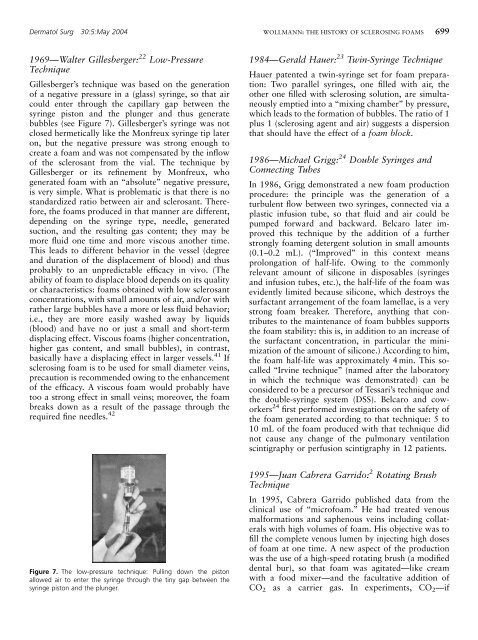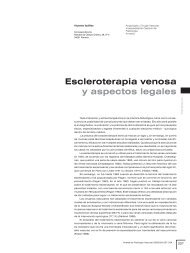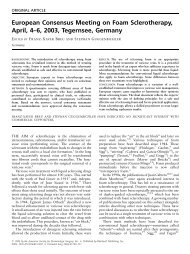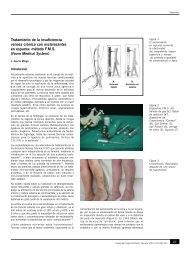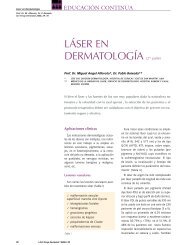The History of Sclerosing Foams
The History of Sclerosing Foams
The History of Sclerosing Foams
You also want an ePaper? Increase the reach of your titles
YUMPU automatically turns print PDFs into web optimized ePapers that Google loves.
Dermatol Surg 30:5:May 2004 WOLLMANN: THE HISTORY OF SCLEROSING FOAMS 699<br />
1969—Walter Gillesberger: 22 Low-Pressure<br />
Technique<br />
Gillesberger’s technique was based on the generation<br />
<strong>of</strong> a negative pressure in a (glass) syringe, so that air<br />
could enter through the capillary gap between the<br />
syringe piston and the plunger and thus generate<br />
bubbles (see Figure 7). Gillesberger’s syringe was not<br />
closed hermetically like the Monfreux syringe tip later<br />
on, but the negative pressure was strong enough to<br />
create a foam and was not compensated by the inflow<br />
<strong>of</strong> the sclerosant from the vial. <strong>The</strong> technique by<br />
Gillesberger or its refinement by Monfreux, who<br />
generated foam with an ‘‘absolute’’ negative pressure,<br />
is very simple. What is problematic is that there is no<br />
standardized ratio between air and sclerosant. <strong>The</strong>refore,<br />
the foams produced in that manner are different,<br />
depending on the syringe type, needle, generated<br />
suction, and the resulting gas content; they may be<br />
more fluid one time and more viscous another time.<br />
This leads to different behavior in the vessel (degree<br />
and duration <strong>of</strong> the displacement <strong>of</strong> blood) and thus<br />
probably to an unpredictable efficacy in vivo. (<strong>The</strong><br />
ability <strong>of</strong> foam to displace blood depends on its quality<br />
or characteristics: foams obtained with low sclerosant<br />
concentrations, with small amounts <strong>of</strong> air, and/or with<br />
rather large bubbles have a more or less fluid behavior;<br />
i.e., they are more easily washed away by liquids<br />
(blood) and have no or just a small and short-term<br />
displacing effect. Viscous foams (higher concentration,<br />
higher gas content, and small bubbles), in contrast,<br />
basically have a displacing effect in larger vessels. 41 If<br />
sclerosing foam is to be used for small diameter veins,<br />
precaution is recommended owing to the enhancement<br />
<strong>of</strong> the efficacy. A viscous foam would probably have<br />
too a strong effect in small veins; moreover, the foam<br />
breaks down as a result <strong>of</strong> the passage through the<br />
required fine needles. 42<br />
Figure 7. <strong>The</strong> low-pressure technique: Pulling down the piston<br />
allowed air to enter the syringe through the tiny gap between the<br />
syringe piston and the plunger.<br />
1984—Gerald Hauer: 23 Twin-Syringe Technique<br />
Hauer patented a twin-syringe set for foam preparation:<br />
Two parallel syringes, one filled with air, the<br />
other one filled with sclerosing solution, are simultaneously<br />
emptied into a ‘‘mixing chamber’’ by pressure,<br />
which leads to the formation <strong>of</strong> bubbles. <strong>The</strong> ratio <strong>of</strong> 1<br />
plus 1 (sclerosing agent and air) suggests a dispersion<br />
that should have the effect <strong>of</strong> a foam block.<br />
1986—Michael Grigg: 24 Double Syringes and<br />
Connecting Tubes<br />
In 1986, Grigg demonstrated a new foam production<br />
procedure: the principle was the generation <strong>of</strong> a<br />
turbulent flow between two syringes, connected via a<br />
plastic infusion tube, so that fluid and air could be<br />
pumped forward and backward. Belcaro later improved<br />
this technique by the addition <strong>of</strong> a further<br />
strongly foaming detergent solution in small amounts<br />
(0.1–0.2 mL). (‘‘Improved’’ in this context means<br />
prolongation <strong>of</strong> half-life. Owing to the commonly<br />
relevant amount <strong>of</strong> silicone in disposables (syringes<br />
and infusion tubes, etc.), the half-life <strong>of</strong> the foam was<br />
evidently limited because silicone, which destroys the<br />
surfactant arrangement <strong>of</strong> the foam lamellae, is a very<br />
strong foam breaker. <strong>The</strong>refore, anything that contributes<br />
to the maintenance <strong>of</strong> foam bubbles supports<br />
the foam stability: this is, in addition to an increase <strong>of</strong><br />
the surfactant concentration, in particular the minimization<br />
<strong>of</strong> the amount <strong>of</strong> silicone.) According to him,<br />
the foam half-life was approximately 4 min. This socalled<br />
‘‘Irvine technique’’ (named after the laboratory<br />
in which the technique was demonstrated) can be<br />
considered to be a precursor <strong>of</strong> Tessari’s technique and<br />
the double-syringe system (DSS). Belcaro and coworkers<br />
24 first performed investigations on the safety <strong>of</strong><br />
the foam generated according to that technique: 5 to<br />
10 mL <strong>of</strong> the foam produced with that technique did<br />
not cause any change <strong>of</strong> the pulmonary ventilation<br />
scintigraphy or perfusion scintigraphy in 12 patients.<br />
1995—Juan Cabrera Garrido: 2 Rotating Brush<br />
Technique<br />
In 1995, Cabrera Garrido published data from the<br />
clinical use <strong>of</strong> ‘‘micr<strong>of</strong>oam.’’ He had treated venous<br />
malformations and saphenous veins including collaterals<br />
with high volumes <strong>of</strong> foam. His objective was to<br />
fill the complete venous lumen by injecting high doses<br />
<strong>of</strong> foam at one time. A new aspect <strong>of</strong> the production<br />
was the use <strong>of</strong> a high-speed rotating brush (a modified<br />
dental bur), so that foam was agitated—like cream<br />
with a food mixer—and the facultative addition <strong>of</strong><br />
CO2 as a carrier gas. In experiments, CO2—if


